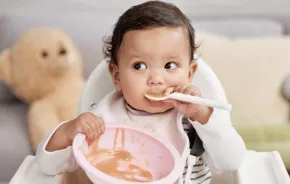Think back to your fifth-grade classroom. Chances are, your experience was more Ferris Bueller than Summerhill School. You sat at your desk and tried to stay attentive while your teacher droned on (and on) about places and dates you didn't remember two weeks later.
"Very few people actually learn that way," says Bridgett Chandler, vice-president and chief programs officer at the Talaris Research Institute in Seattle. "And fewer learning environments now use that as an approach. It's just not effective."
The teaching method that's grown in acceptance and popularity over that last decade is called "child-centered learning." It's a technique -- and a philosophy of education -- that promises to focus on the student, not the teacher. Child-centered learning highlights collaboration: Instructors, child care providers and parents take their cues from the kids, drawing upon their interests, needs and natural curiosities.
Early learning experts encourage parents to think about settings that are child-centered when shopping for preschools and kindergartens -- and when interacting with their own young children. "Child-centered learning is huge for school readiness," Chandler says. "It means the child has had adults saying to him, "I know you are a learner. I trust you as someone who has good ideas.'"
A group of 3-year-olds began chatting about the word "power" one day in preschool. What was power? Who had it? "This conversation spawned a month-long exploration of the concept of power," says Chandler, whose daughter was one of the 3-year-olds in the class.
The children painted and talked about what happened when they drew one color on top of another. Red, they found, was stronger than yellow. Then the teacher placed a glob of clay in front of them. If paint had power, did other things have power, too?
That, Chandler notes, is child-centered learning. "Most of the time, when people think about teaching kids, it's about what they want the children to know," she says. "When instruction is child-centered, the child is trusted as someone who is capable of having his or her own ideas about how the world works. The teacher is there to interact, based on what the child shows her is important, interesting and delightful."
Is the child-centered learning method effective? Diane Kroll thinks so. Kroll is director of early childhood services for the Puget Sound Educational Service District. "When you're doing something that engages you, you are more likely to remember it and want to do more," she says.
That's how it works for youngsters. "When children are able to explore and be involved, they will hold on to that information," Kroll says. "It sticks."
Children develop self-confidence and begin to trust their own capabilities when they play a role in their own education, Kroll says. "A child-centered environment creates a love of knowledge. In a child-centered environment, children feel competent, capable and ready to learn."
Child-centered learning can begin early, says Susan Hakoda, resource specialist for child care providers at Child Care Resources. "Infants aren't verbal, but they communicate in other ways," she says. "It's up to adults to pick up on their cues."
Is your toddler losing interest in a story? Switch gears, Hakoda says. The key is to stay in tune and in touch with your child's interests and needs. "You have to know how and when to throw in an extra prop or toy," Kroll says.
Enriching children's environments this way can affect their social and emotional growth, Hakoda says. "When it's all about them, it makes them feel good."
Often, adults get in the way of making learning fun, Hakoda says. She warns parents to avoid drilling, testing and quizzing.
"We think that's the way children learn, because that's how we were taught," she says. "But they'll learn just as well if we just talk to them about shapes and numbers. It's not about teaching them math at age 2; it's about giving them experiences with things they can count."
Keep questions open-ended, she suggests. "Rote testing doesn't engage the child's mind. After a while, the child shuts down."
The best instructors -- whether teachers or parents -- offer children a wide range of experiences, Hakoda says. "Explain what you are doing and what you see the child doing. Every so often, you can ask, 'Can you pass me the red orange?' Instead of being your child's teacher, you can be their guide."
Linda Morgan writes frequently on education issues for ParentMap.
Originally published in the February, 2007 print edition of ParentMap.









